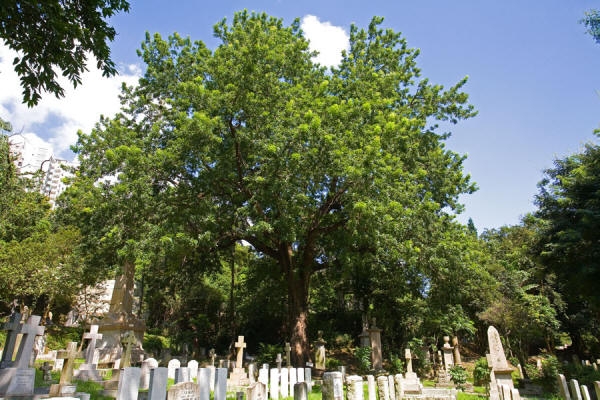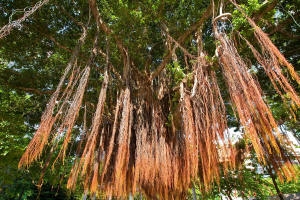“King of Hong Kong” Urban Trees Competition was hosted by Provisional Urban Council, and co-hosted by The Conservancy Association and RTHK. The nine Urban King Trees elected re now listed in the Register of Old and Valuable Trees.
One third of the tree trunks of the Chinese Banyan, known as ‘King of Hong Kong Urban Tree’, collapsed in Kowloon Park on 13thAugust 2007. The collapse alerted the public tothe inadequacy of tree conservation works, especially those of Old and Valuable Tree in Hong Kong. In September, the Conservancy Association surveyed the remaining eight Urban King Trees. We discovered that most of them received inappropriate care, with three of them having potential collapsing risks.
Trees are important assets to asociety and conservation work should not be ignored. While the Administration hadspent enormous amount of public money on tree planting and urban greening, sufficient resource should also be put on tree conservation.Below were the Urban King Trees with problems:
| Eastern | Wan Chai | Central & Western |
| Southern | Yau Tsim Mong | Sham Shui Po |
| Kowloon City | Kwun Tong | Wong Tai Sin |
Chinese Banyan (Ficus microcarpa) LCSD E/16



| Health conditions | Fair, slow growth, vigorous production of watersprouts on the tree trunk and branches;5-10% dieback. |
| Structure | Many old pruning wounds; sign of decay on some of the wounds as well as parts of roots near roadside; aerial roots were removed; many branches were lion tailed. |
| Environment description | The tree crown was closedto buildings nearby;tree roots were covered by roadsurface, lackingof space for further development. |
| Comparison with growth situationin 1997 | The tree crown sizereduced by pruning led to reduced weight;however, no aerial roots could reach the ground and lignified, seriously affectingthe health and the support of the tree. |
West Indies Mahogany (Swietenia mahagoni) LCSD WCH/23



| Health conditions | Good, 5-10% dieback. |
| Structure | Wounds due to improper pruning inthe lower part of trunk, signs of decay, fungi on several branch surfaces may indicate internal decay, but not serious. |
| Environment description | 30% of the roots grew under the paved trail in the cemetery, mightaffect long term growth. |
| Comparison with growth situationin 1997 | Tree crown denser, indicating good health conditions, no serious structural problem. |
Burmese Rosewood (Pterocarpus indicus)LCSD CW/86
https://www.cahk.org.hk/upload/subpage2/88/self/619f65fec3a90.jpg



| Health conditions | Good, 5% dieback, but yellow leaves and dark green veins mightindicate malnourishment (probably deficiency of iron). |
| Structure | Wounds due to improper pruning mainly inthe lower part of the tree trunk;some of the larger wounds covered with concrete. |
| Environment description | 70% of the roots covered, compacted soil. |
| Comparison with growth situationin 1997 | Tree crown denser, overall health conditionsgood;but concrete covering the trunk showedsign of loosening, posingpotential hazard. |
Rain Tree (Albizia saman)LCSD S/9




| Health conditions | Good, growth normal, but water sproutsfoundat various locations;10% dieback. |
| Structure | Formation of wound wood at several locations,withsome of the wounds quite large, two showingsigns of decay;many pruning wounds also showedsigns of decay;trunk leans towards Wong Chuk Hang Road, with roots on opposite side growingunder concrete, exposing parts showedsigns of decay. |
| Environment description | High chancecollapsingtowards Wong Chuk Hang Road due to leaning and decaying root;insufficient space for root growth, 80% of the roots covered. |
| Comparison with growth situationin 1997 | The leaning angle more acute,withtree crown onthe side of a private nursery thinner than at the side of Wong Chuk Hang Road, indicating possibleroot problems;crown should be thinned to reduce weight. |
Chinese Banyan (Ficus microcarpa)LCSD YTM/97


| Health conditions | Very poor, only 20% tree crown left; fewaerial roots, but some reach ground;lots of die-back, indicatingserious root problems. |
| Structure | One-third of trunk collapsed, slight leaning;pruning wounds found at many branches and aerial roots, all showingsigns of decay. |
| Environment description | Large area of roots once covered with concrete/tiles;roots truncated due to engineering works,seriously damaging roots and affecting absorption of water and minerals. |
| Comparison with situation in1997 | Overall condition very poor, high chanceof dying. |
Silk-tree (Albizia julibrissin)LCSD SSP/16
Remark: The tree was removed in 2015.



| Health conditions | Good, dense tree crown, with minor water sprouts onmain trunk and branches. |
| Structure | Several pruning wounds, some show signs of decay; formation of wound wood at several locations;several branches lion-tailed. |
| Environment description | 60% roots covered, seriously affectingabsorption of water and minerals;part of roots under a fencing wall, impact unknown. |
| Comparison with growth situation in 1997 | Leaning angle more acute,withlocal residents pointingout that two large brancheshadcollapsed and caused damage to the buildings nearby;tree crown should be thinned and supported with CORBA bracing. |
Chinese Banyan (Ficus microcarpa)LCSD KC/1



| Health conditions | Good, slow growth;5-10% die-back;few aerial roots. |
| Structure | Several pruning wounds;show signs of decay, many pruned aerial roots, several branches lion-tailed. |
| Environment description | 10-20% of roots covered by tiles and road, locating mainly on one side; probablyleadingto imbalancedgrowth;soil compacted and hard. |
| Comparison with growth situationin 1997 | Main trunk widened from 0.6m to 1.8m because of aerial roots , but those far from the main trunk couldn’treach ground, probablyaffecting futurehealth and support,in the long run;main trunk beganto age, thus allowing aerial roots to reach groundwould becomevery important for the caring of the tree;extension of tree crown hinderedgrowth of other trees. |
Silk-tree (Albizia julibrissin) HD KT/1



| Health conditions | Good;5% die back. |
| Structure | Several pruning wounds, some showingformation of wound woods, but some also showingsigns of decay; two large cuts (with diameter in40cm), probablyleadingto internal decay;long term monitoringworkneeded. |
| Environment description | Ample space for growth and off limited to passers-by thus, protection enough. With installation of flood light, effect of the heat to the tree should be closely monitored; the installation process might haveinjuredthe roots. |
| Comparison withgrowth situationin 1997 | Tree crown thinner, but conducive to reducing the weight of the crown. |
Chinese Banyan (Ficus microcarpa) LCSD WTS/8



| Health conditions | Good, but several locations with water sprouts;lush growth of aerial roots. |
| Structure | Several pruning wounds with water sprouts, branches facing the park square might havebeentopped because of the construction works. |
| Environment description | Located at the park entrance, 90% of the roots covered with tiles;aerial roots pruned and could not reach the ground. |
| Comparison withgrowth situationin 1997 | Not many changes, the location of the entrance should be moved toprovide more space for the root system and aerial roots, reducinghuman disturbance to the tree. |

